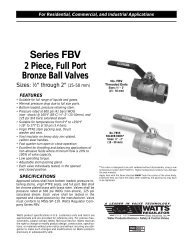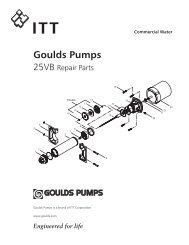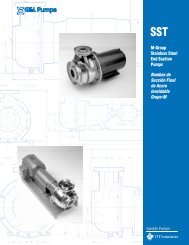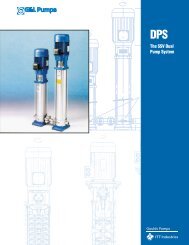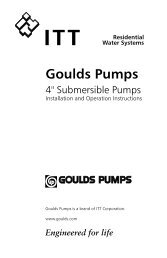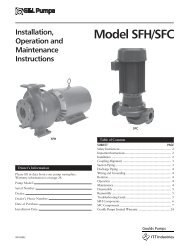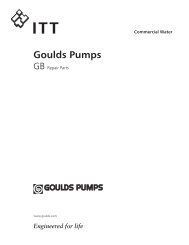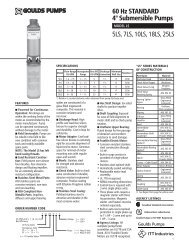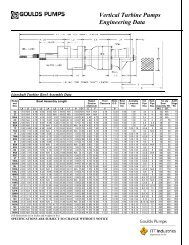SubDrive Duplex Alternator
SubDrive Duplex Alternator
SubDrive Duplex Alternator
Create successful ePaper yourself
Turn your PDF publications into a flip-book with our unique Google optimized e-Paper software.
Diagnostic Fault Codes<br />
<strong>SubDrive</strong> <strong>Duplex</strong> <strong>Alternator</strong><br />
In the event that a problem occurs with one of the two Drive systems and the<br />
unit is unable to meet demand properly, the <strong>Alternator</strong>’s diagnostics will detect<br />
the problem and alert the user with a “Fault” light and close a set of dry contacts<br />
that can be connected to an external alarm. The red “Fault” light will fl ash a<br />
given number of times to indicate the nature of the fault. After a fault has been<br />
corrected, the <strong>Alternator</strong> can be reset by holding down the “Switch Pump or<br />
Clear Fault” button for 5 seconds or by removing power. The <strong>Alternator</strong> may also<br />
see that the system is functioning normal again and self clear the FAULT light<br />
and alarm. Fault codes and the recommended corrective action for each are<br />
listed in the chart.<br />
# of<br />
Flashes<br />
1<br />
2<br />
3<br />
4<br />
5<br />
6<br />
Fault Possible Cause Corrective Action<br />
System 1 down<br />
or shorted low<br />
pressure sensor<br />
System 2 down<br />
or shorted low<br />
pressure sensor<br />
Open high<br />
pressure sensor<br />
Leads to Drive 1<br />
are open circuit<br />
Leads to Drive 2<br />
are open circuit<br />
Pressure<br />
sensors not<br />
set far<br />
enough apart<br />
System 1 is not meeting<br />
demand properly or<br />
lower set pressure<br />
sensor is shorted<br />
System 2 is not meeting<br />
demand properly or<br />
lower set pressure<br />
sensor is shorted<br />
Leads to higher set<br />
pressure sensor may be<br />
open or broken or the<br />
sensor itself may have<br />
failed to open<br />
Leads from Drive 1 to<br />
<strong>Alternator</strong> are damaged<br />
or not connected<br />
Leads from Drive 2 to<br />
<strong>Alternator</strong> are damaged<br />
or not connected<br />
Pressure sensor<br />
differential’s too close.<br />
Both Drives are trying to<br />
meet system demand at<br />
the same time<br />
Check Drive 1’s front panel for<br />
possible fault code and follow<br />
corrective actions for that fault code.<br />
Make sure that Drive 1 has a green<br />
light (i.e. it has power). If there is no<br />
fault code and a green light is present,<br />
check the lower set pressure sensor to<br />
see if its contacts are shorted together.<br />
Check Drive 2’s front panel for<br />
possible fault code and follow<br />
corrective actions for that fault code.<br />
Make sure that Drive 2 has a green<br />
light (i.e. it has power). If there is no<br />
fault code and a green light is present,<br />
check the lower set pressure sensor to<br />
see if its contacts are shorted together.<br />
Check the leads to the higher set<br />
pressure sensor. Check the sensor<br />
itself. Check the leads to <strong>Alternator</strong>’s<br />
terminal block.<br />
Check leads from Drive 1 to <strong>Alternator</strong>.<br />
Check connection at terminal block of<br />
Drive 1 and connection at <strong>Alternator</strong><br />
terminal block.<br />
Check leads from Drive 2 to <strong>Alternator</strong>.<br />
Check connection at terminal block of<br />
Drive 2 and connection at <strong>Alternator</strong><br />
terminal block.<br />
Adjust pressure sensors so the PSI<br />
difference is great enough to get only<br />
one drive to run at a time; at least 3<br />
psi should be enough difference.<br />
16



